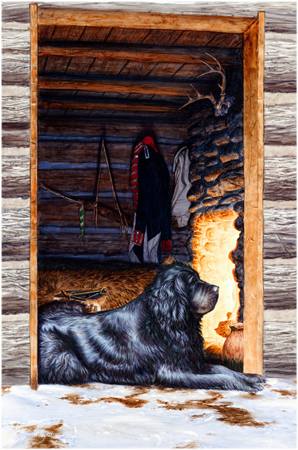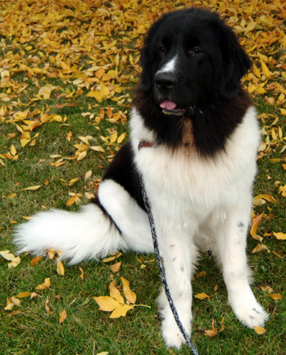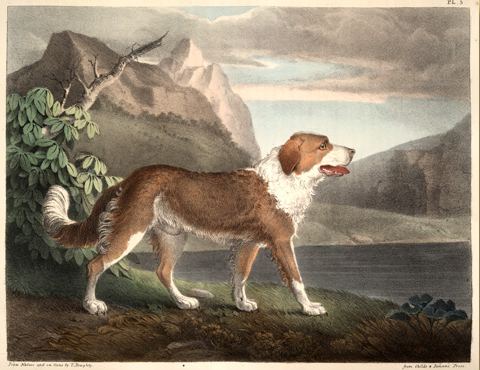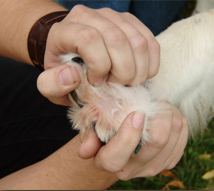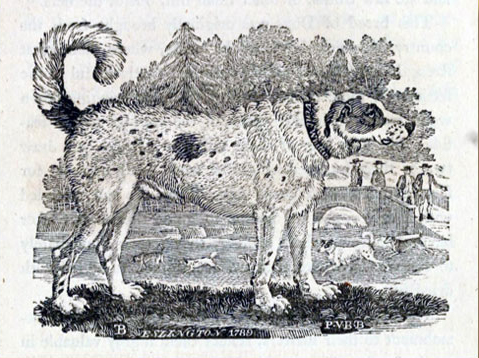“The dog was of the newfoundland breed
one that I prised much for his docility
and qualifications generally
for my journey.”
Seaman’s Sagacity
With the arrival of William Clark and his party at the “forks of Jefferson’s River” on Saturday morning, 17 August 1805, and the erection of a shady canopy of sails supported by willow poles at the site the party would call “Fortunate Camp,” the stage was set for the reunion of Sacagawea with her people, and the mutual embraces of two cultures, old Lemhi Shoshone and new American.
Following Meriwether Lewis‘s long harangue about the purposes of their visit, to which Chief Cameahwait cheerily responded with promises of friendship and cooperation, came the visitors’ honorific gifts—peace medals, fine clothing, tobacco, and “some small articles” for the chiefs—followed by presents for others, a mixture of familiar Indian favorites such as paint, moccasins, and beads, along with tokens of some of civilization’s benefits—awls, knives, and mirrors. The whole affair came off as a rousing success. The Shoshones seemed duly impressed. “They had indeed abundant sources of surprise in all they saw,” Lewis exulted. “The appearance of the men, their arms, their clothing, the canoes, the strange looks of the negro, and the sagacity of our dog, all in turn shared their admiration.”[1]Nicholas Biddle, The Journals of the Expedition Under the Command of Capts. Lewis and Clark, . . . Performed during the Years 1804-5-6. By Order of the Government of the United States; prepared for … Continue reading
The Shoshones, like all other Indian people, had owned, bred, trained, used, and loved dogs from the dimmest days of their own origins. What was it, then, about “our dog” that thrilled them so? Certain it is that they recognized an ineffable quality that Seaman seemed to possess, both in his attitudes and his actions. We don’t know whether the Indians had a name for it or not, but Lewis called it sagacity.
Knight, the Newfie
© 2005 VIAs Inc.
Play Knights “voice”
Courtesy of Danette Paige and Knight, Missoula, Montana.
Barking—”giving tongue”—just for the noise of it did not come naturally to the breed. “The Newfoundland Dog in his native country, seldom barks,” wrote Thomas Doughty (1793-1856) in his Cabinet of Natural History, “and that, only when much provoked.”[2]John and Thomas Doughty, The Cabinet of Natural History and American Rural Sports, 2 vols. (Philadelphia, 1830-32), 1 (1830):54. Internet Archive, … Continue reading “His utterance,” the author continued, “appears an unnatural exertion, producing a noise between a bark and a growl.” That may have been true of the Newfoundlands within Doughty’s acquaintance, but it doesn’t sound that way today, coming from a descendant many dog-generations distant from the early 19th century. Nevertheless, it is still very difficult to tease a Newfoundland into barking for no apparent reason.
Knight, only five months old when this photo was taken, would sound a full-throated woof when the doorbell rang, or when someone unfamiliar entered his environment, but his master was present here today, so he was fully at ease and making friends with the stranger.
We can only surmise that Seaman’s “note” was similar to Knight’s, and if so, that his gruff, resonant voice would have startled most Indians, as well as their characteristically quiet dogs.
Newfoundland Dog
Canis familiaris, Var. sensilis[3]Pronounced CANE-iss fam-ill-ee-AIR-iss. The specific epithet means “familiar.” The Variety, pronounced sen-SILL-iss, is Latin for “sensible.” Of the lithograph Doughty wrote: … Continue reading
Ewell Sale Stewart Library, The Academy of Natural Sciences, Philadelphia
Hand-colored lithograph (1830)
“From Nature and on Stone by T. Doughty”
The Cabinet of Natural History and American Rural Sports (1830)
“Extremely docile and affectionate, this Dog may be taught to perform actions which appear almost incredible, and which, seeminglly, require no slight exercise of the reasoning faculties. Equally sagacious as persevering, he never relinquishes an undertaking as long as there remains the most distant hope of success . . . . The great pliability of his temper, peculiarly fits him for the use of man, as he never shrinks from any task that may be assigned him, but he undertakes it with an ardour proportioned to the difficulty of the execution.”[4] The Cabinet of Natural History and American Rural Sports, 3 vols. , Vol. 1 (1830): 53.
Those must have been the qualifications Lewis recognized and felt assured of when he bought Seaman.
Thomas Doughty (1793-1856) was a well-known Philadelphia artist whose landscapes were especially popular, though some critics dismissed him as “a leaf painter.” The setting of Doughty’s conception of the Newfoundland is almost identical with that of Philip Reinagle, yet historians have recognized him as one of the initiators of the American “Hudson River School” of artists. It was neither an institution nor an organization but a view of nature common among a number of different artists, most notably Thomas Cole (1801-1848) and Asher B. Durand (1796-1886). Typically, they placed their subjects in imposing wild settings beside noble rivers. Their towering mountains were chiefly based on sketches made among the palisades on the Hudson River, but conceived in the rarified atmospheres of their respective imaginations within the sanctuaries of their studios.
Quick of Scent or Thought
Noah Webster’s definition of that word in his Compendious Dictionary[5] Noah Webster, A Compendious Dictionary of the English Language. . . . (1806; reprint, New York: Crown Publishers Inc., 1970). tersely specified the two connotations it bore in Lewis and Clark’s day: “quick of scent or thought; acute.” The expression “quick . . . of thought” was an allusion to the mental processes of acute discernment, or to behavior indicating a capacity to relate means to ends, and anticipate outcomes. Throughout the late 18th and early 19th centuries, writers were quick to notice those attributes in any animal. Indeed, for some 200 years the sagacity of a wide variety of wild animals had been studied in order to measure their position in the Great Chain of Being by identifying evidence of seemingly rational—i.e., human–behavior.[6]The climax of anthropomorphism was probably reached early in the 20th century by William T. Hornaday, a founder of the New York Zoological Society, in his collection of essays on The Minds and … Continue reading The habits and strategies of spiders and honey bees was admired in the late 18th century, for example.
William Clark, without bringing up the word, admired the intricate engineering of a beaver dam (2 August 1805): “the brush appear to be laid in no regular order yet acquires a strength by the irregularity with which they are placed by the beaver that it would puzzle the engenuity of man to give them.” Patrick Gass told of an unobserved but evidently sagacious pack of wolves: “At 9 [on 8 September 1804] I went out with one of our men, who had killed a buffaloe and left his hat to keep off the vermin and beasts of prey; but when we came to the place, we found the wolves had devoured the carcase and carried off the hat.” What’s more, the body of a white wolf was found at the scene, possibly the victim in a battle over salvage rights. However, the word “sagacity” was generally reserved for dogs, and especially for Newfoundland dogs.
For some reason or other the word sagacity must have been on Lewis’s mind during the days he spent among the Shoshones, for he invoked it three times within two weeks, and never before nor afterwards. On 11 August 1805, after having anxiously sought the elusive Shoshones for more than a month, he was exasperated with George Drouillard and Shields for not obeying his signals to stand still, which ruined his first opportunity to make contact with a lone Shoshone horseman. The lone Indian had almost reached speaking distance from Lewis, but he grew suspicious when he saw Drouillard and Shields approaching, and sped away. Lewis accused his two companions of not “haveing segacity [sagacity] enough to recollect the impropriety of advancing when they saw me thus in parley with the Indian.”
Two weeks later, Charbonneau drew Lewis’s wrath by failing to report some gossip he had heard: The Shoshones were thinking of heading out immediately for the autumn buffalo hunt and leaving their American visitors in the lurch. “I was out of patience with the folly of Charbono,” Lewis grumbled sarcastically, “who had not sufficient sagacity to see the consequencies which would inevitably flow from such a movement of the indians.” In other words, Drouillard, Shields, and poor old Toussaint in turn were each, at least in those crucial instances, dumber ‘n a dog! Certainly dumber ‘n Seaman!
The essence of sagacity is concentrated in a famous epitaph on the estate of the English poet Lord Byron (1788–1824) at Newstead Abbey, Nottinghamshire, England:
Near this spot
Are deposited the Remains of one
Who possessed Beauty without Vanity,
Strength without Insolence,
Courage without Ferocity,
And all the Virtues of Man without his Vices.This Praise, which would be unmeaning Flattery
If inscribed over human Ashes,
Is but a just tribute to the Memory of BOATSWAIN, a DOG,
Who was born in Newfoundland May 1803
And died at Newstead Nov. 18th, 1808.[7] Henry P. Davis, The New Dog Encyclopedia, 3d ed. (Harrisburg, Pennsylvania: Stackpole, 1970), s.v. “Newfoundland.”
Guard Dog
Seaman not only had smarts. He was “quick of . . . scent,” too. In Taplin’s words, a Newfoundland dog had “an instantaneous sense of impending danger” that could take over when human watchmen were lulled into apathy. Seaman was true to his breed. He was quick to take action on 29 May 1805 when a bison rampaged through camp in the middle of the night. Needing no orders from his master, he fearlessly flew at the brute and turned it away from the heads of the men who were sleeping near the campfire. On another dark night he “barked very much and seemed extremly uneasy which was unusual with him,” so Lewis sent three soldiers to reconnoiter the camp perimeter on the chance that either hostile Indians or ferocious grizzlies were lurking in the dark. It turned out to be a false alarm—merely a solitary bison that had tried but failed to swim the river near camp and had been swept downriver by the current. But Seaman had done his job anyway.
Later, the Corps found the vicinity of the upper portage camp, at White Bear Islands above the Great Falls of the Missouri, to be infested with grizzlies. Seaman, Lewis reported, seemed to be “in a constant state of alarm with these bear and keeps barking all night.” One night (17 June 1805), despite Seaman’s alarums a “white bear” came to within 30 yards of their bivouac and ate “about thirty weight of buffaloe su[e]t which was hanging on a pole.” And again, after Reubin Field wounded a moose one morning near the Blackfoot River (7 July 1806), Seaman, with the savvy of a veteran mountain man who would know that a moose could be as dangerous as a grizzly, was obviously “much worried.”
Large semi-palmated (webbed) paws on sturdy legs beneath muscular shoulders qualify Newfoundlands as eager, strong swimmers, equal to the challenges of fast rivers and heavy surf.
Newfoundland dog (1789)
Wood engraving by Thomas Bewick (1753-1828), from A General History of Quadrupeds (1800), BHLsiki (2010).
Thomas Bewick drew this portrait of “a very fine” specimen of the Newfoundland breed at the village of Eslington, Northumberland, England, in 1789. It was notably large, being of the size characteristic of the species native to the Channel Islands, especially Newfoundland. He reported its dimensions as follows:
From its nose to the end of its tail, it measured six feet two inches; the length of its tail, one foot ten inches; from one fore foot right over its shoulders to the other, five feet seven inches; girt[h] behind the shoulder, three feet two inches; round its head over its ears, two feet; round the upper part of its fore leg, nine inches and a half. It was web-footed (Fig. 6), could swim extremely fast, dive with great east, and bring up any thing from the bottom of the water.
Those figures clearly substantiate Taplin’s description of the dog’s use as a draft animal on Newfoundland Island. It was frequently observed, however, that the breed as it was known in England and America at the turn of the 19th century, was somewhat smaller than its North Atlantic forebears but still displayed the essential qualities of its canine heritage.[8]At least one 18th-century naturalist rejected the thesis of the breed’s uniqueness. Thomas Pennant (1726-1798) wrote of the dogs of Newfoundland in general: “It is not certain that there … Continue reading
Retriever
Lewis’s “very active strong and docile” canine companion also possessed another of the breed’s much-vaunted attributes, a “partiality for water, in which he appears in his proper element, diving and keeping beneath the surface for a considerable time.”[9]Ibid.
On the day (5 July 1804) the expedition “came to for Dinner at a Beever house,” Seaman, apparently unbidden, “went in & drove them out.” It may have been the dog’s very presence in the water that spooked the rodents, but it could be he actually dove down to one of the submerged entrances and stuck his head in to browbeat them into flight.
Seaman surely earned his keep with his affinity for water. He swam into swarms of migrating gray squirrels crossing the Ohio river, picking off a few fat ones for his master’s dinner. He chased and caught a pregnant pronghorn doe in “a fair race.” He caught another “goat” swimming across the Missouri, “drowned it and brought it on shore.” He retrieved wounded deer on several occasions. Waterfowl were irresistible challenges: “My dog caught several [geese] today, as he frequently dose,” Lewis remarked offhandedly. On another occasion Seaman’s eagerness nearly caused him to bleed to death when a wounded beaver bit him on a leg and punctured the artery.
The downside of the Newfoundland’s primary talent is a tendency to be undiscriminating about which rescues are desirable. The painter Landseer illustrated that with his amusing “Friends” (1824), in which a dripping-wet all-black Newfie proffers his frowning mistress a child’s toy sailboat he has just fetched from a nearby pond.
Achilles’ Heel
Seaman’s sagacity entitled him to human sympathies from time to time. He suffered as much as the rest of the party from the onslaughts of mosquitoes—”my dog even howls with the torture he experiences from them” (15 July 1805). Throughout the Great Plains, the ubiquitous needle-and-thread grass (Stipa comata), with its sharp, barbed awn that attached itself to poor Seaman’s dense coat, was especially noxious. “My poor dog suffers with them excessively,” wrote Lewis. “He is constantly [biting] and scratching himself as if in a rack of pain.” (26 July 1805) The oppressive August heat on the South Dakota prairie forced both Seaman and York to retreat to a nearby stream for relief.
Today the Newfoundland’s life expectancy is only about 10 years; 200 years ago it may have been even shorter. Its primary vulnerability at that time, according to contemporary authorities, was a susceptability to rabies. “Unfortunately,” wrote Doughty, “this sagacious and faithful animal is liable to disease, which is communicable to almost all animals that he may bite whilst labouring under it; the human species appears to be peculiarly liable, under such circumstances, to be inoculated with this horrible, and, alas! almost incurable malady.”[10]Ibid., 1:52.
Hugh Heney, the cordial trader from the North West Company who befriended Lewis and Clark at Fort Mandan, called to Lewis’s attention the narrow-leafed purple coneflower (Echinacea angustifolia DC var. angustifolia), as an antidote for rabies: Clark, on 28 February 1805, recorded the prescription for application: “the way of useing it is to scarify the part when bitten to chu or pound an inch or more if the root is Small, and applying it to the bitten part renewing it twice a Day. the bitten person is not to chaw nor Swallow any of the Root for it might have contrary effect.” It also worked for rattlesnake bites. The coneflower must have been an important discovery, in view of the fear of rabies on the East Coast, for under “Remarks” for 18 March 1805 Lewis “collected Some herbs pla[n]ts in order to send by the boat. paticularly the root said to cure the bites of the mad dog and rattlesnake.” Perhaps Heney’s gift was prompted by some discussion among the three men that centered on the sagacious but vulnerable Seaman.
Big Dog
Perhaps another feature that impressed the Shoshones on that August day in 1805 was Seaman’s size, compared with most Indian dogs. Although Lewis had occasionally mentioned Indian dogs on the way up the Missouri, they must have been rather ordinary-looking, for he took no pains to record any details. Later he penned a concise description of the typical Indian dog west of the Rockies: It was, wrote Lewis:
unusually small, about the size of an ordinary cur; he is usually parti-coloured, amongst which, the black, white, brown, and brindle are the colours most predominant; the head is long, the nose pointed, the eyes small, the ears erect and pointed like that of the wolf; the hair is short and smooth, excepting on the tail, where it is long and straight, like that of the ordinary cur-dog.[11]This is from Biddle’s paraphrase of Lewis’s original journal for 16 February 1806; that was all anyone had to go on until Thwaites published the complete journals in 1904. Lewis himself … Continue reading
The zoological history of Indian dogs was still a murky subject among naturalists at the time, and the study of it was considered a matter of obvious importance. Benjamin Smith Barton, in an article on “Native Dogs of North America” concluded: “We are not yet prepared to give an exact genealogical history of the Indian Dog. We are compelled to mix conjecture with fact. The anatomical structure of the animal should be examined. But whatever may have been the origin of this breed of dogs, I am disposed to think, . . . that the savages found it in the woods, and that it has existed as a distinct species, or breed, for a very long period of time.”[12]The Philadelphia Medical and Physical Journal (Philadelphia: J. Conrad & Co., 1804-1808), vol. I, part 2, p. 3. Quoted in William Guthrie, A New Geographical, Historical, and Commercial Grammar; … Continue reading
Lewis left us no clues as to Seaman’s physical features, but in the late 1820s John Godman compared a typical Newfoundland with Lewis’s description of the Indian dog. The Newfoundland dog, he concluded:
has a broader and more expressive visage, and a blunter nose, . . . the orbits of his eyes have more prominent superciliary ridges, the ears are broad, soft and pendulous, and the whole body is more robust, and covered with long, soft and glossy hair. On the tail the hair is still longer than on the body and forms a handsome brush, which appears to greater advantage when the animal is in motion, as it is then carried slightly curbed upwards at its extremity.[13]Godman, 1: 254.
From a human’s perspective, those “prominent superciliary ridges,” or eyebrows, undoubtedly lent the dog’s countenance a more serious, intense—even thoughtful—expression than that of more ordinary dogs.
Thomas Doughty gave some typical measurements of a Newfoundland, and indicated their significance:
A full sized Newfoundland Dog, from the nose to the end of the tail, measures about six feet and a half, the length of the tail being about two feet; from one fore foot to the other over the shoulders, three feet four inches; round the head across the ears, two feet; round the upper part of the fore leg, ten inches; length of the head, fourteen inches . . . . This Dog is not remarkable for symmetry of proportions, and his motions are heavy; consequently, he is not distinguished for speed.[14]Doughty, 1:53. In the mid-18th-century mongrel denoted either a mixed-breed dog of uncertain parentage or, more specifically, the offspring of a wolf and a dog.
However, the British traveler Edward Chappell, claimed that by 1818 “the . . . true breed has become scarce, and is rarely to be found, except upon the coast of Labrador.”[15]Edward Chappell, Voyage of His Majesty’s Ship Rosamond to Newfoundland and the Southern Coast of Labrador. (London: J. Mawman, 1818), 141. “The generality of the Dogs known under the name of Newfoundland, both in England and this country, are only half bred.” Lewis left us no specific information from which we might deduce Seaman’s size, but he did remark (16 November 1803) that he had paid $20 for him—half a month’s salary for an Army captain—which suggests that either Lewis knew dogs well enough to be qualified to make an intelligent choice, or he got some excellent advice.
Notes
| ↑1 | Nicholas Biddle, The Journals of the Expedition Under the Command of Capts. Lewis and Clark, . . . Performed during the Years 1804-5-6. By Order of the Government of the United States; prepared for the press by Paul Allen, 2 vols. (Philadelphia, 1814), 2:165. In his original journal Lewis continued, “I also shot my air-gun which was so perfectly incomprehensible that they immediately denominated it the great medicine.” For a discussion of Lewis’s dog’s name, see Seaman’s Creek. |
|---|---|
| ↑2 | John and Thomas Doughty, The Cabinet of Natural History and American Rural Sports, 2 vols. (Philadelphia, 1830-32), 1 (1830):54. Internet Archive, http://www.archive.org/details/cabinetofnatural01phil (accessed November 11, 2010). The Newfoundland, presented as a retriever, was the only domestic canid discussed by the Doughtys in either volume. |
| ↑3 | Pronounced CANE-iss fam-ill-ee-AIR-iss. The specific epithet means “familiar.” The Variety, pronounced sen-SILL-iss, is Latin for “sensible.” Of the lithograph Doughty wrote: “We are indebted to J. Browne Smith, Esq. for an opportunity of figuring this majestic animal, from a remarkably fine and well marked specimen in his possession. The Philadelphia Museum is also enriched by a well prepared example of this Dog, which formerly belonged to Mr. Wistar, of Germantown.” The Museum was that of Charles Willson Peale (1741-1827), whom John and Thomas Doughty memorialized with a long biographical essay as a preface to the first volume of The Cabinet of Natural History and American Rural Sports, 3 Vols. (Philadelphia, 1830-33), 1:i-vii. Caspar Wistar (1761-1818) was a close friend of Thomas Jefferson, and one of Lewis’s Philadelphia mentors. |
| ↑4 | The Cabinet of Natural History and American Rural Sports, 3 vols. , Vol. 1 (1830): 53. |
| ↑5 | Noah Webster, A Compendious Dictionary of the English Language. . . . (1806; reprint, New York: Crown Publishers Inc., 1970). |
| ↑6 | The climax of anthropomorphism was probably reached early in the 20th century by William T. Hornaday, a founder of the New York Zoological Society, in his collection of essays on The Minds and Manners of Wild Animals (New York: Scribner’s, 1922): “The wild animal must think, or die.” |
| ↑7 | Henry P. Davis, The New Dog Encyclopedia, 3d ed. (Harrisburg, Pennsylvania: Stackpole, 1970), s.v. “Newfoundland.” |
| ↑8 | At least one 18th-century naturalist rejected the thesis of the breed’s uniqueness. Thomas Pennant (1726-1798) wrote of the dogs of Newfoundland in general: “It is not certain that there is any distinct breed: most of them are curs, with a cross of the mastiff: some will, and others will not, take the water, absolutely refusing to go in. The country was found uninhabited, which makes it more probable that they were introduced by the Europeans.” Arctic Zoology, 2 vols., 1784 (Reprint, New York: Arno Press, 1974), 1:39-41. Pennant’s conjecture remains arguably acceptable to at least one authority. Desmond Morris, Dogs; the Ultimate Dictionary (North Pomfret, Vermont: Trafalgar Square Publishing, 2001), 670. |
| ↑9 | Ibid. |
| ↑10 | Ibid., 1:52. |
| ↑11 | This is from Biddle’s paraphrase of Lewis’s original journal for 16 February 1806; that was all anyone had to go on until Thwaites published the complete journals in 1904. Lewis himself wrote “usually,” not “unusually.” |
| ↑12 | The Philadelphia Medical and Physical Journal (Philadelphia: J. Conrad & Co., 1804-1808), vol. I, part 2, p. 3. Quoted in William Guthrie, A New Geographical, Historical, and Commercial Grammar; and Present State of the Several Kingdoms of the World, 2 vols. (Philadelphia: Johnson Warner, 1815), 1: 294. |
| ↑13 | Godman, 1: 254. |
| ↑14 | Doughty, 1:53. |
| ↑15 | Edward Chappell, Voyage of His Majesty’s Ship Rosamond to Newfoundland and the Southern Coast of Labrador. (London: J. Mawman, 1818), 141. |
Experience the Lewis and Clark Trail
The Lewis and Clark Trail Experience—our sister site at lewisandclark.travel—connects the world to people and places on the Lewis and Clark Trail.
Discover More
- The Lewis and Clark Expedition: Day by Day by Gary E. Moulton (University of Nebraska Press, 2018). The story in prose, 14 May 1804–23 September 1806.
- The Lewis and Clark Journals: An American Epic of Discovery (abridged) by Gary E. Moulton (University of Nebraska Press, 2003). Selected journal excerpts, 14 May 1804–23 September 1806.
- The Lewis and Clark Journals. by Gary E. Moulton (University of Nebraska Press, 1983–2001). The complete story in 13 volumes.
